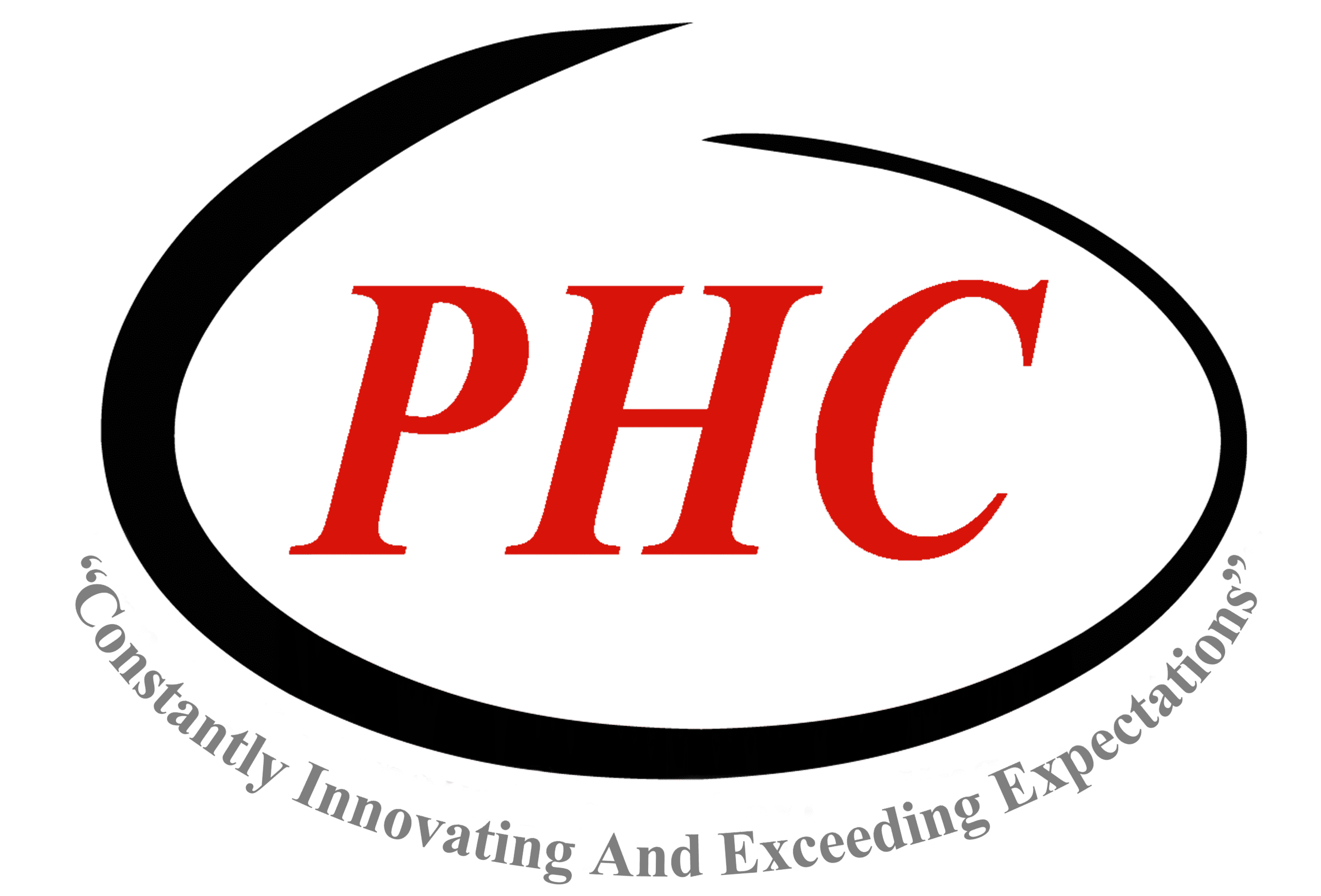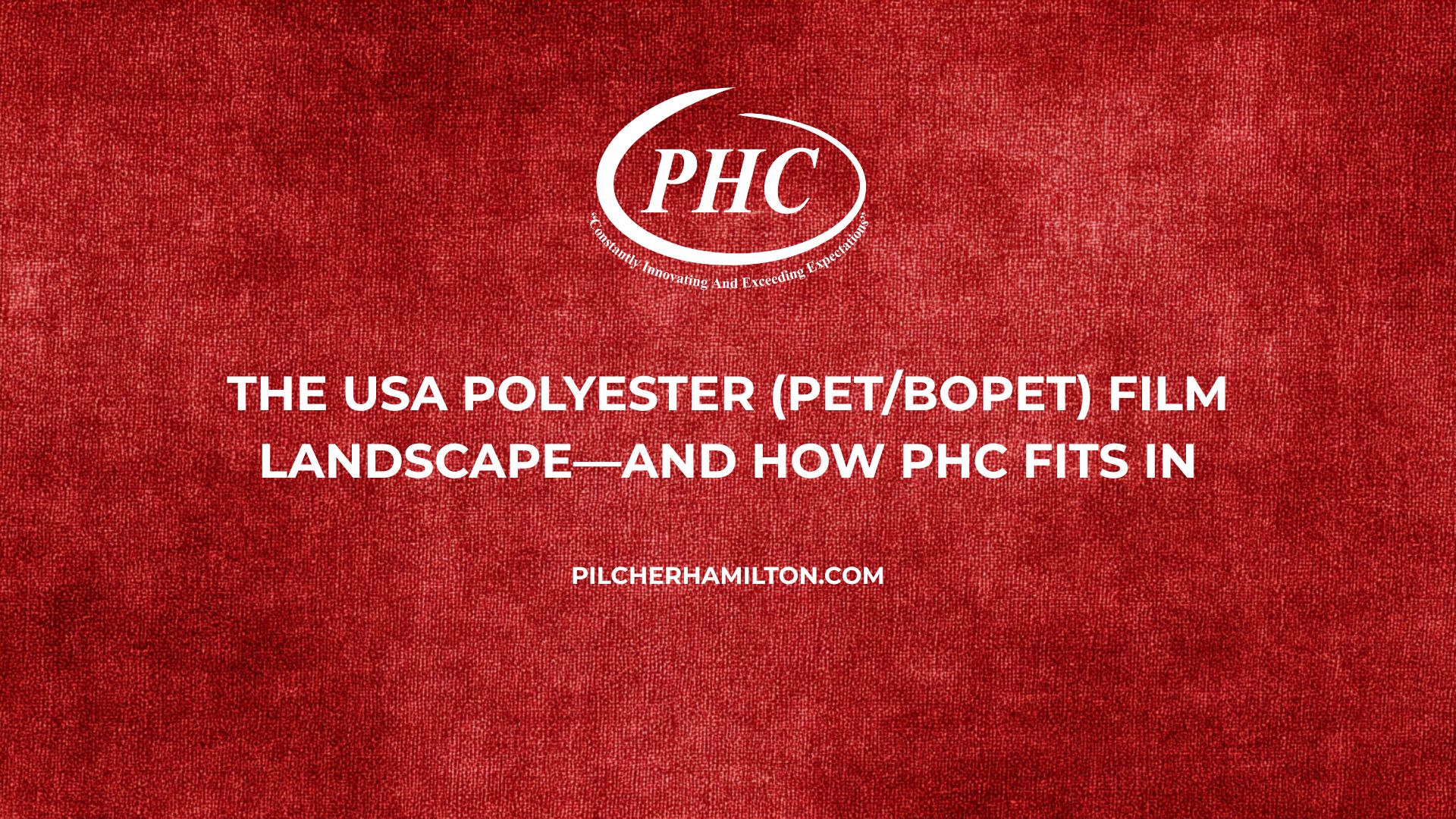Summary for engineers and buyers: Primary polyester film (PET/BOPET) manufacturing in the U.S. is clustered in a handful of states, with South Carolina, Virginia, Alabama, Rhode Island, Georgia, Kentucky, and New York playing outsized roles. Pilcher Hamilton Corporation (PHC) is not a primary film manufacturer—we are a merchant supplier and converter—but our Greer, SC converting hub sits in the middle of the largest U.S. polyester ecosystem and is positioned to integrate supply from these producers with value‑added converting (slitting, coating, corona treatment, sheeting, winding, toll converting) and rapid, 24–48‑hour shipments from an inventory exceeding 10,000,000 lb. Learn more about our supplier overview and all services.
1) Where primary BOPET is made in the U.S. (2024–2025 snapshot)
South Carolina (SC) — Mitsubishi Polyester Film, Greer
Greer is one of the country’s anchor sites for BOPET. Mitsubishi Polyester Film (MPF) has run major capacity expansions here, including a $100M project announced in 2015 and a subsequent 2018 ribbon‑cutting celebrating the world’s largest polyester film line at the site.
Virginia (VA) — DuPont Teijin Films / Mylar Specialty Films, Chester–Hopewell
DuPont Teijin Films’ U.S. polyester film manufacturing and HQ functions are centered around Chester/Hopewell, VA. Public records and certifications list Chester/Hopewell addresses for Mylar/Melinex operations and slitting/distribution. Note that DuPont’s Florence, SC PET film plant closed in 2010 as DTF consolidated U.S. PET film production to Virginia.
Clarification about Ohio: DuPont’s Circleville, OH site—often mentioned in broader film conversations—produces Kapton® polyimide films (not PET). Multiple DuPont releases confirm Circleville expansions for Kapton/Pyralux, not BOPET.
Alabama (AL) — Polyplex USA, Decatur
Polyplex operates a large PET film complex in Decatur, AL, with a new second PET film line and a dedicated coating line added as part of a ~$100M expansion entering service during 2024–2025.
Rhode Island (RI) — Toray Plastics (America), North Kingstown
Toray’s Lumirror® division produces polyester films in North Kingstown, RI, alongside Torayfan® (OPP) on the same campus.
Georgia (GA) — SK microworks America (formerly SKC), Covington
SK’s Covington campus has manufactured polyester films since the late 1990s; state releases and company materials highlight continued investment and significant U.S. PET film market share.
Kentucky (KY) — Flex Films (UFlex), Elizabethtown
UFlex’s U.S. site in Elizabethtown, KY includes BOPET film production and converting; public materials reference an ~30,000 TPA PET line.
New York (NY) — Terphane, Bloomfield
Terphane historically operated BOPET manufacturing at Bloomfield, NY; local reporting indicates the site’s closure announced in April 2025.
What about Pennsylvania (PA) and “Jindal”?
Some summaries attribute PET film production in PA to Jindal; in practice, Jindal Films’ U.S. production footprint is focused on BOPP/BOPE, with manufacturing in Shawnee, OK and a regional base in Georgia, not PET in PA. Pennsylvania remains an important converting and distribution corridor (labels/liners/industrial films).
The upshot: PHC’s Greer, SC converting hub is physically proximate to Mitsubishi’s Greer site and logistically well‑connected to VA/AL/RI/GA/KY/NY clusters—ideal for quick base‑web changes, risk‑balanced sourcing, and urgent replenishment.
2) PHC’s role: merchant supplier + converter (not primary manufacturing)
PHC sources high‑quality base PET/BOPET from the U.S. producers above and then applies value‑added converting at our Greer, SC hub:
- Slitting to width: 1–60 in, ±0.005 in tolerance; 3″/6″ cores. Learn more about slitting.
- Sheeting to 60″ × 100″, ±0.010 in. See sheeting.
- Roll‑to‑roll coating (typical add‑on 0.5–5 µm): PVDC, silicone, acrylic, anti‑fog, anti‑static. See coating.
- Corona treatment to target surface energy 38–52 dyn/cm. See corona treated.
- Winding / Rewinding with tension/camber control and splice protocols. See winding.
- Toll converting (customer‑supplied webs), minimum runs ≈ 1,000 lb. See toll converting.
This “secondary manufacturing” footprint lets your team dial in performance without holding unique base webs on your floor—PHC carries inventory and converts to spec, fast.
3) Technical ranges you can spec through PHC (engineer‑ready)
- Gauge (thickness): 8–200 µm (≈0.32–7.87 mil). Common stock: 12, 23, 36, 48, 50, 75, 100, 125, 190 µm.
- Surface energy (dyne): 38–52 dyn/cm (corona or chemical). Corona‑treated PET, Chemical‑treated.
- COF: 0.2–0.6 film/film depending on slip system and coating. Silicone release faces: typically 0.2–0.4. Silicone Release.
- Barrier:
- Metallized PET: OTR <1 cc/m²·day, WVTR <1 g/m²·day (typical 23 °C testing). Metallized, Barrier PET Films.
- PVDC‑coated PET: OTR 5–10 cc/m²·day, transparent barrier. PVDC‑Coated.
- Metallized PET: OTR <1 cc/m²·day, WVTR <1 g/m²·day (typical 23 °C testing). Metallized, Barrier PET Films.
- Heat‑seal windows: 200–400°F (93–204°C) overall; typical 250–350°F for peelable PET/APET/CPET/PP lidding structures. Heat‑Sealable.
- Electrical insulation: Dielectric >3 kV/mil; UL‑recognized grades for motors/slot liners. Electrical Insulating UL.
- Clarity: Graphic grades with haze <1%; treated for ink/adhesive anchorage. High‑Clarity Graphics.
- Sustainability: PCR PET up to 90% recycled content; corona treated 38–44 dyn; metallizable/printable options. PCR Films, Sustainability Solutions.
Note: Actual performance depends on exact structure (primer, slip additives, barrier coat, treatment, thickness) and your line conditions (dwell/pressure/jaw profile). We tune COF, dyne, and seal curves to your machine and partner materials.
4) Typical “good / better / best” picks by application
- High‑barrier snacks/coffee:
- Best: mPET12 (metallized 12 µm) + PE; OTR <1, WVTR <1.
- Better: PVDC‑PET12 (5–10 OTR) for transparent barrier.
- Add dyne ≥42 and robust primer for aggressive ink systems.
See Metallized and PVDC‑Coated.
- Best: mPET12 (metallized 12 µm) + PE; OTR <1, WVTR <1.
- APET/CPET tray lidding:
- Heat‑sealable PET 12–36 µm; peelable to APET/CPET; seal 250–330°F; COF tuned for 0.3–0.5 to avoid web “stick‑slip.”
See Heat‑Sealable.
- Heat‑sealable PET 12–36 µm; peelable to APET/CPET; seal 250–330°F; COF tuned for 0.3–0.5 to avoid web “stick‑slip.”
- PSA label/graphics liners:
- Silicone‑coated PET 23–75 µm; COF 0.2–0.4, differential release options; backside printable acrylic coat as needed.
See Silicone Release and Release Liners for PSAs.
- Silicone‑coated PET 23–75 µm; COF 0.2–0.4, differential release options; backside printable acrylic coat as needed.
- Electrical insulation / industrial:
- Industrial/UL PET 50–190 µm; dielectric >3 kV/mil; camber‑managed slitting ±0.005″.
See Electrical PET Converting.
- Industrial/UL PET 50–190 µm; dielectric >3 kV/mil; camber‑managed slitting ±0.005″.
- Sustainable laminations:
- PCR PET (30–90% PCR), dyne 38–44; metallize for high barrier; align with your APR/reclaimer guidance.
See PCR Films.
- PCR PET (30–90% PCR), dyne 38–44; metallize for high barrier; align with your APR/reclaimer guidance.
5) Why PHC’s Greer, SC hub is strategic (national supply, local speed)
Being minutes from Mitsubishi Polyester Film’s Greer plant and within efficient lanes to VA/AL/RI/GA/KY/NY lets PHC:
- Shorten replenishment loops when you change base webs or coatings late in a project.
- Trial quickly (A/B structures) by drawing from our >10M‑lb inventory and nearby primary lines.
- Stabilize logistics with multiple U.S. source options if one site is in outage or under allocation.
If your SOP demands dual‑source base PET, PHC can qualify parallel suppliers within the clusters above and hold converted safety stock in Greer.
(Context sources on the clusters: MPF Greer; DTF consolidation to VA (Florence closed 2010); Polyplex Decatur expansions; Toray RI; SK Covington; UFlex KY; Terphane NY status).
6) RFQ data that gets you a correct film on the first pass
Include these fields:
- Structure & target: e.g., mPET12//PE70 aiming OTR <1, WVTR <1; or PVDC‑PET12 for see‑through barrier.
- Gauge: 8–200 µm (tolerance, caliper method).
- Surfaces: Side A/B dyne (38–52), corona vs chemical, primer/coatings.
- COF: static/kinetic targets (e.g., 0.2–0.6 film/film; specify film/steel if relevant).
- Seal: partner (APET/CPET/PP/PE), seal window (200–400°F), peel vs weld, peel force (N/15 mm), dwell/pressure profile.
- Optics: haze %, gloss GU; or opacity 85–95% for white films.
- Electrical (if needed): dielectric (kV), UL class.
- Roll build: slit width ±0.005″, OD/length, cores (3″/6″), splice rules, defect map.
- Compliance: FDA / food‑contact; PCR % claims; traceability.
- Logistics: delivery point, release schedule, and any 24–48 h ship‑from‑stock requirements.
You can browse categories here and reference them by link in your RFQ—Metallized • PVDC‑Coated • Heat‑Sealable • Silicone Release • General‑Purpose Industrial • Electrical UL • PCR PET.
7) Sustainability, clarified
- PCR content: We support up to 90% PCR PET grades (printable and metallizable), with 38–44 dyn targets; we can metallize or coat for barrier upgrades where needed. PCR PET.
- Waste minimization: Toll convert your webs with razor/score slitting, defect mapping, and optimized roll builds to reduce trims/scrap. Toll Converting.
- Barrier vs recycle‑ready: Where recycle‑ready PE/BOPE structures are required, we’ll propose PET roles in mono‑material or detachable builds, or pivot to BON/PET hybrids where performance requires it. BON standards.
8) Quick conversions & performance notes
- 1 mil = 25.4 µm. Common gauges: 12 µm ≈ 0.47 mil, 23 µm ≈ 0.91 mil, 50 µm ≈ 2.0 mil, 100 µm ≈ 3.9 mil, 200 µm ≈ 7.9 mil.
- Seal windows: PET‑seal lidding often runs 250–350°F; overall PET systems can span 200–400°F depending on seal layer chemistry.
- COF: 0.3–0.5 is a practical “machineability” window for HFFS/VFFS; 0.2–0.3 for silicone release liners; 0.5–0.6 for high‑COF “no‑slip” packaging faces (ask about high COF/low slip).
Practical buying playbook by region
- Southeast (SC/GA/AL): For shortest lanes into PHC Greer, base PET from Greer (MPF) and Covington (SK) plus Decatur (Polyplex) can be combined with PHC PVDC/silicone/acrylic coatings and precision slitting to meet barrier (OTR <1) and COF 0.3–0.5 targets quickly.
- Mid‑Atlantic (VA/PA): Pull from Chester–Hopewell, VA for Mylar/Melinex base webs; PA is strong in labels/liners converting—PHC supplies silicone‑coated PET (COF 0.2–0.4) and acrylic‑treated print faces with dyne ≥42.
- Northeast (RI/NY): Toray RI Lumirror bases + PHC coatings are common in graphics/electronics; Terphane NY was a historical source—verify current availability due to the 2025 closure announcement.
Ohio note: If your spec mentions “OH/VA DuPont,” keep PET from VA and recognize OH as polyimide (Kapton) rather than BOPET; PHC can still convert Kapton where appropriate but will quote differently due to material cost/handling.
How to proceed
- Send your RFQ with gauge, dyne, COF, barrier, seal window and roll build targets. We’ll return two to three ready‑to‑run film options (e.g., mPET12 OTR <1, PVDC‑PET12 OTR 5–10, silicone‑PET COF 0.2–0.4) tuned to your line.
- Or ask for a regional plan: we’ll align base PET from the nearest primary producer to your plant and convert in Greer, SC for the shortest critical path.
Relevant PHC links:
All Products • All Services • Metallized • PVDC‑Coated • Silicone Release • Heat‑Sealable • General‑Purpose Industrial • Electrical UL • PCR PET.
Citations for manufacturing context (selected)
- Mitsubishi Polyester Film – Greer, SC expansions and site: company releases and contact pages.
- DuPont Teijin Films – VA site, Florence SC closure (2010): EPA records, chamber listings, ISO certificate.
- DuPont Circleville, OH – Kapton (polyimide), not PET: DuPont press releases.
- Polyplex USA – Decatur, AL expansion: trade/industry coverage.
- Toray Plastics (America) – Lumirror, North Kingstown, RI: company site/contact.
- Flex Films – Elizabethtown, KY: UFlex/Flex Films pages and plant media.
- SK microworks America (SKC) – Covington, GA: state release, company/press materials.
- Terphane – Bloomfield, NY: manufacturer listing and 2025 closure news.
- Jindal in the U.S. – BOPP/BOPE focus; no PET in PA: Jindal Films location pages.
Contact & locations
Contact PHC at info@pilcherhamilton.com or visit contact‑us. Serving the USA from: 850 South Buncombe Road, Greer – South Carolina.

